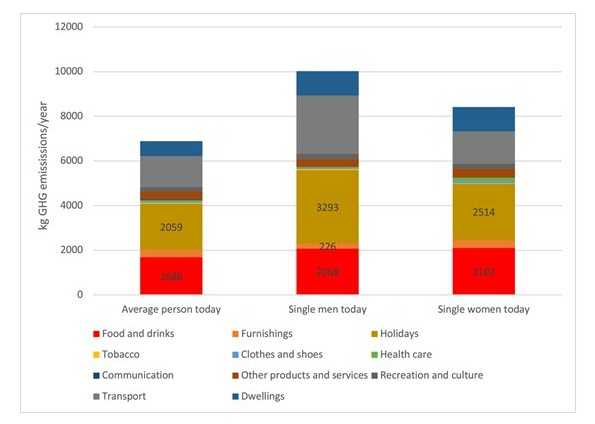Shifting expenditure on food, holidays, and furnishings could lower greenhouse gas emissions by almost 40%
Authors: Annika Carlsson Kanyama, Jonas Nässén, René Benders.
Journal: Journal of Industrial Ecology 2021; 1– 15.
Abstract
This paper investigates how consumption-based greenhouse gas emissions from private households can be reduced. The aim is to quantify opportunities for mitigation through shifting expenditure on food, holidays, and furnishings to less carbon-intensive products and services that are available on the market but not yet mainstream. Two hundred and seventeen analyses of the greenhouse gas emissions/SEK for on-the-market products and services were used for estimating the consumption-based greenhouse gas emissions from an average person, an average single man and an average single woman. The consumption-based greenhouse gas emissions for these households were estimated to be 6.9, 10, and 8.5 tonnes per capita per year respectively; and food, holidays, and furnishings accounted for 56–59% of that. The alternatives to mainstream food, holidays, and furnishings include plant-based alternatives to meat and dairy products, locally produced vegetables, second-hand or repaired furnishings, holidaying abroad by train, and “staycations.” Our results show that total greenhouse gas emissions can be lowered by 36–38% by shifting the expenditure on these products and services to less carbon-intensive alternatives without changing the total expenditure. The share of total emissions deriving from food, holidays, and furnishings is reduced to 30–35% after the change. The findings are discussed in the light of goals for reductions in greenhouse gas emissions, additional sustainability aspects, the limitations of the study and needs for further research. This article met the requirements for a silver–silver JIEdata openness badge described at http://jie.click/badges.

In the news:
- Men cause more climate emissions than women, study finds | The Guardian
-
Dat meen je niet … Mannen veroorzaken meer broeikasgas dan vrouwen | Technisch Weekblad
More news
-
15 September 2025
Successful visit to the UG by Rector of Institut Teknologi Bandung
